Fabric guide roller
The cloth guide roller is a common device in open-width dyeing and finishing equipment. Its main function is to support and guide the fabric to run in a certain direction, and to adjust the tension of the fabric in the running direction.
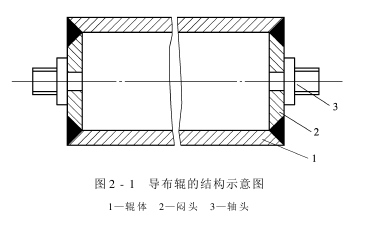
Guide cloth The structure of the roller is shown in Figure 2-1, which consists of three parts: the shaft head, the bulkhead and the roller body. The shaft head is the supporting part when the cloth guide roller is installed. The shaft head can be made into a stepped short shaft of different shapes according to the form of the supporting bearing and the movement of the cloth guide roller. The roller body is generally made of chromium-plated seamless steel pipe or stainless steel pipe. It can also be covered with a coating to form a roller surface of different materials, such as soft rubber roller, hard rubber roller, nylon roller, etc. The shaft head and the roller body are connected by welding through the bulkhead.
According to the different idle states of the cloth guide rollers, the cloth guide rollers can be divided into fixed cloth guide rollers and movable cloth guide rollers, and the movable cloth guide rollers can be divided into active cloth guide rollers and passive cloth guide rollers according to different power sources.
Under different leisure states and power sources, the friction between the cloth guide roller and the flat fabric is different, and accordingly the tension produced by the fabric is affected differently, thereby changing the finishing state of the fabric and ultimately affecting the dyeing and finishing quality. Therefore, it is necessary to analyze the friction between the cloth guide roller and the flat fabric and understand its relationship with the changes in the tension (especially the warp tension) of the flat fabric.
Let’s analyze the changes in warp tension when the open-width fabric passes through the guide roller. For the convenience of discussion, the surface condition of the cloth guide roller surface and the flexible deformation of the flat fabric will not be analyzed for the time being.
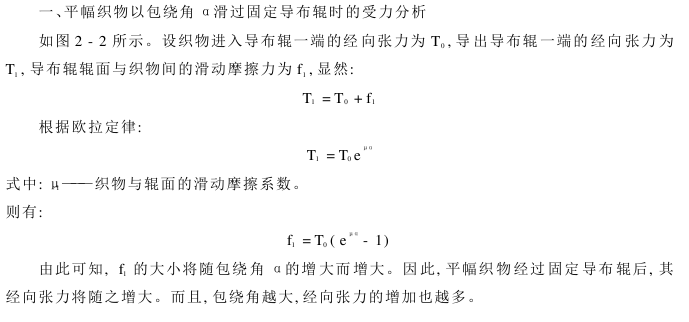
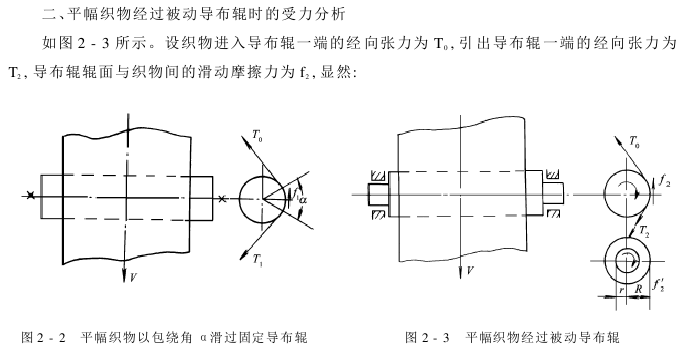
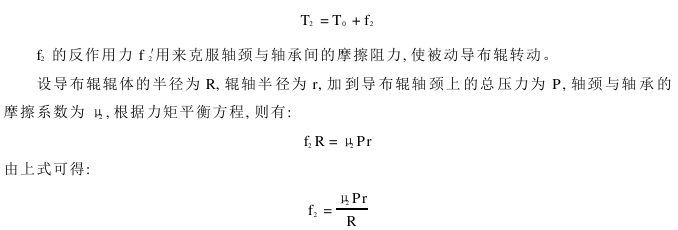
Therefore, after the open-width fabric passes through the passive guide roller, its warp tension will also increase. The more passive guide rollers the open-width fabric passes through, the more the warp tension increases.
It is common in dyeing and finishing equipment for open-width fabrics to drag multiple cloth guide rollers. For example, in the flat washing tank of a flat washing machine, there are multiple passive cloth guide rollers arranged up and down. The fabric passes between the guide rollers to increase the number of cleanings and extend the cleaning time. In order to reduce the warp tension of the fabric, the cloth guide roller bearings must be kept well lubricated.
3. Stress analysis of open-width fabric when passing through the active cloth guide roller
As shown in Figure 2-4. Assume that the warp tension at the end of the fabric entering the guide roller is T0, and the warp tension at the end of the guide roller is T3. The space between the surface of the guide roller and the fabric The static friction force is f3, the external torque driving the cloth guide roller to rotate is M, and the radius of the cloth guide roller body is R. Obviously:

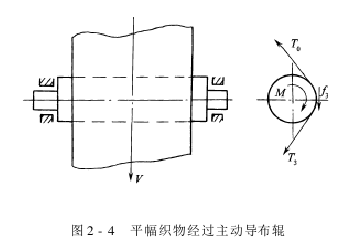
Therefore, after the open-width fabric passes through the active cloth guide roller, its warp tension will be reduced. The more active guide rollers the open-width fabric passes through, the more the warp tension is reduced.
If the warp tension of the fabric is too small, it will relax and even wrinkle during operation. In order to overcome this problem, the active cloth guide roller is sometimes run at overspeed. In this way, a certain amount of slippage occurs between the fabric and the surface of the cloth guide roller.
Assuming that the sliding friction between the fabric and the surface of the cloth guide roller is f4, and the warp tension at the output end of the fabric during slippage is T’3, then:

In this way, due to the overspeed slipping of the active cloth guide roller, the warp tension of the fabric increases. For example, the drop roller in the open-width cloth discharging device often uses an active cloth guide roller, and maintains a 1:1106 overspeed operation with the speed of the traction roller to prevent the fabric from relaxing and wrinkling.
Since the surface of the cloth guide roller is in direct contact with the fabric, the roller surface is required to be straight and smooth without any burrs and defects. For the rotating shaft type cloth guide roller, it is also required that the roller surface and journal have good concentricity, the installation must be straight, the rotation must be sensitive, and the bearing must have good lubrication performance.
AAASDGGERY6UFGH
Extendedreading:https://www.yingjietex.com/product/Polyester-Three-Color-Scalariform-Lateral-Cut-OXFORD-Fabric.html
Extendedreading:
Extendedreading:
Extendedreading:
Extendedreading:
Extendedreading:
Extendedreading:
Extendedreading:
Extendedreading:
Extendedread





